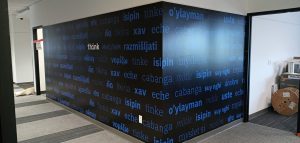
Indoor graphics, as the name implies, are used in indoor environments and include a wide variety of applications. Photo courtesy Mattatall Sign Limited
What do my customers want?
Think about the applications that you currently offer. Which ones are the most profitable, and which do the customers perceive as having the most value? What are the critical market trends in the industries being served, and how will these trends impact the applications currently being offered or are being considered?
Why should my customers buy from me?
Individual buyers and organizations evaluate products and services to determine whether they provide the desired benefits. A strong value proposition must be developed as part of the targeted marketing approach. A value proposition is a 30-second ‘elevator pitch’ to outline the benefits a product or service provides to a buyer. It illustrates why the product or service is superior to competing offers. The value proposition answers the key question, “Why should I buy from you?”
Key verticals buying wide-format applications
Many industries purchase wide-format applications, but some spend more than others. A research study by Keypoint Intelligence—InfoTrends identified the percentage of print budget spending on signage by key industries. The study surveyed more than 1000 small- and medium-sized businesses across 12 industries. Respondents were asked to think about the communication materials they printed and were then asked to specify the percentage that signage like posters, banners, and presentation boards represented for overall print spending. The results were as follows:
- Hospitality: 21 per cent
- Retail: 13 per cent
- Real Estate: 12 per cent
- Government: 11 per cent
- Non-profit: nine per cent
- Education: eight per cent
- Personal Services: seven per cent
- Healthcare: seven per cent
- Insurance: five per cent
- Manufacturing: five per cent
- Professional Services: three per cent
- Financial: two per cent
Endless possibilities
The possibilities for wide-format applications are endless and may seem a bit overwhelming as a result. An important step in determining which applications to offer is ensuring the right printing equipment. Wide-format inkjet printers can vary widely in size and price depending on the indoor/outdoor graphics or specialty applications that are used to produce. Inkjet printers use piezoelectric print heads to deposit tiny droplets of ink directly onto a substrate. The ink is bonded or cured to the substrate using thermal heat or light, such as a heater or UV lamp system, depending on the type of ink used.
There are three primary types of wide-format printers, including flatbed, roll-to-roll, and hybrid systems (capable of printing rolled as well as flat substrates). Each printing technology has its own strengths and limitations, so the applications being produced—now and in the future—can help dictate the printer type that is right for the company.





